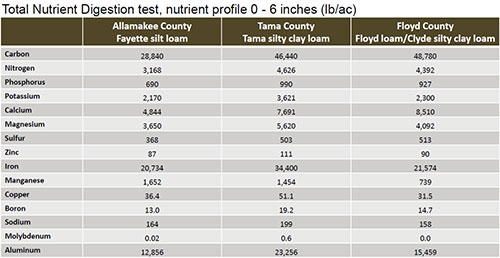You are here
Home ›What's Up at the USDA Office?

Upcoming Deadlines/Dates
October 31: Organic Certification Cost-Share and Transition/Education Certification Program
December 5: Last day to return COC ballots
December 9: Dairy Margin Coverage Program
December 15: Crop Reporting for Fall-Seeded Small Grains
Consider No P Application Next Year
by LuAnn Rolling, District Conservationist
Now is the time to be considering inputs for your 2023 crop. According to Dan Kaiser with the University of Minnesota, the application of P fertilizer is common, but it is not always required to achieve maximum yield. In an article posted in Nutrient Management, Precision Agriculture, Soil Health, he says that while applying crop removal rates is equivalent to hitting the easy button, if P is not required for the crop, the money spent on P fertilizer is likely best spent elsewhere.
According to Brian Dougherty, Ag Engineer with ISU Extension, producers that are working to improve soil health may be able to reduce or eliminate P applications over time. “In natural ecosystems, plants acquire phosphorus from P solubilizing bacteria in the root rhizosphere and form root-associated mycorrhizal fungi that can drill into soil aggregates and even dissolve solid rock to access nutrients. Applying soluble P fertilizers near the root zone inhibits this process.” He adds that plants feed carbon (a food source) to the bacteria and fungi in exchange for P and other nutrients. If the plant has access to soluble P from applied fertilizer, the plant will use that P rather expending extra energy to supply carbon to bacteria and fungi in exchange for P. The same is true for nitrogen and other nutrients. Tillage disrupts mycorrhizal fungi and inhibits this process. Seed-applied insecticides and fungicides can also inhibit P uptake by suppressing bacteria and fungi in the root zone.
One goal in a soil health management system is to minimize disturbance and the use of soluble fertilizers and pesticides to maximize the plant’s ability to access nutrients directly from the soil. Dougherty says that when producers hear this, they are often concerned about ‘mining’ their soil. He cites the table below that shows a selection of soils from different counties in Iowa and their nutrient content based on a total nutrient digestion soil test. “This test accounts for all nutrients, not just those that show up as ‘available’ on a standard soil test. As the table shows, there is around 700 to 1000 lb of P just in the top 6 inches of soil,” Dougherty said. “Most of this P is bound tightly to soil minerals and is not plant available. It will only become available via the biological pathway described above.”
“These soils have average fertility for their area. The P concentration stays relatively steady to 3 ft or more into the soil profile. The table also does not account for P in soil or parent material deeper in the profile. In a typical Midwestern field with grain removal and zero P applied it would take hundreds of years to ‘mine’ this P from the soil profile via soil bacteria and fungi, not including additional P made available during that time by biological activity.” Dougherty said. “This timeframe becomes thousands to hundreds of thousands of years in a well-managed livestock system with minimal soil erosion and manure returned to the field.“
The key to making this work is to implement the soil health principles. Phase out practices that cause erosion and inhibit soil biology (e.g. pesticides and excessive tillage and fertilizer applications) and add practices that feed soil biology and add organic matter (e.g. cover crops and biological amendments) during this transition. Keeping a living root in the ground year-round is critical. Run strip trials periodically with various P application rates to determine how much can be removed without an economic loss.

